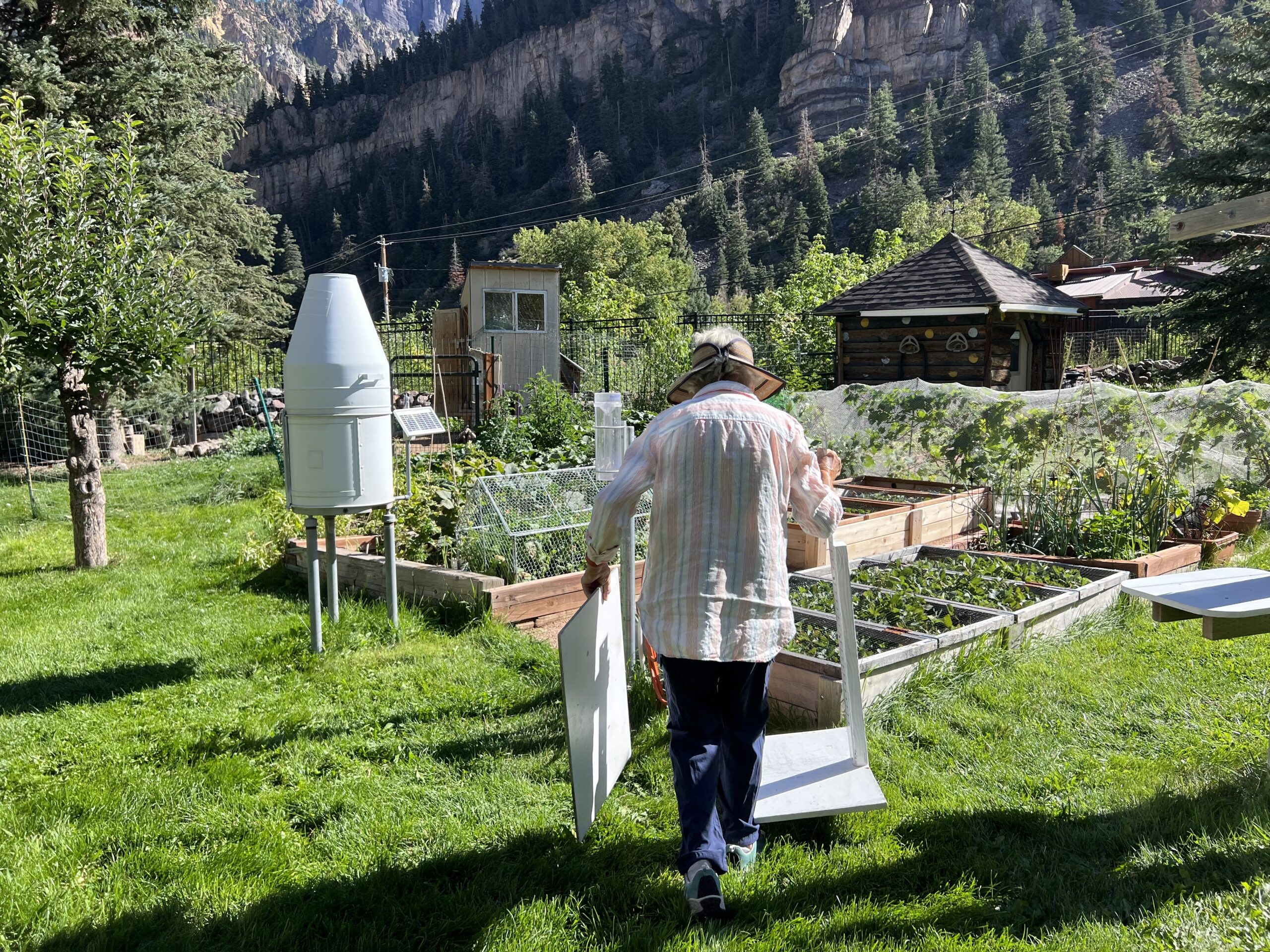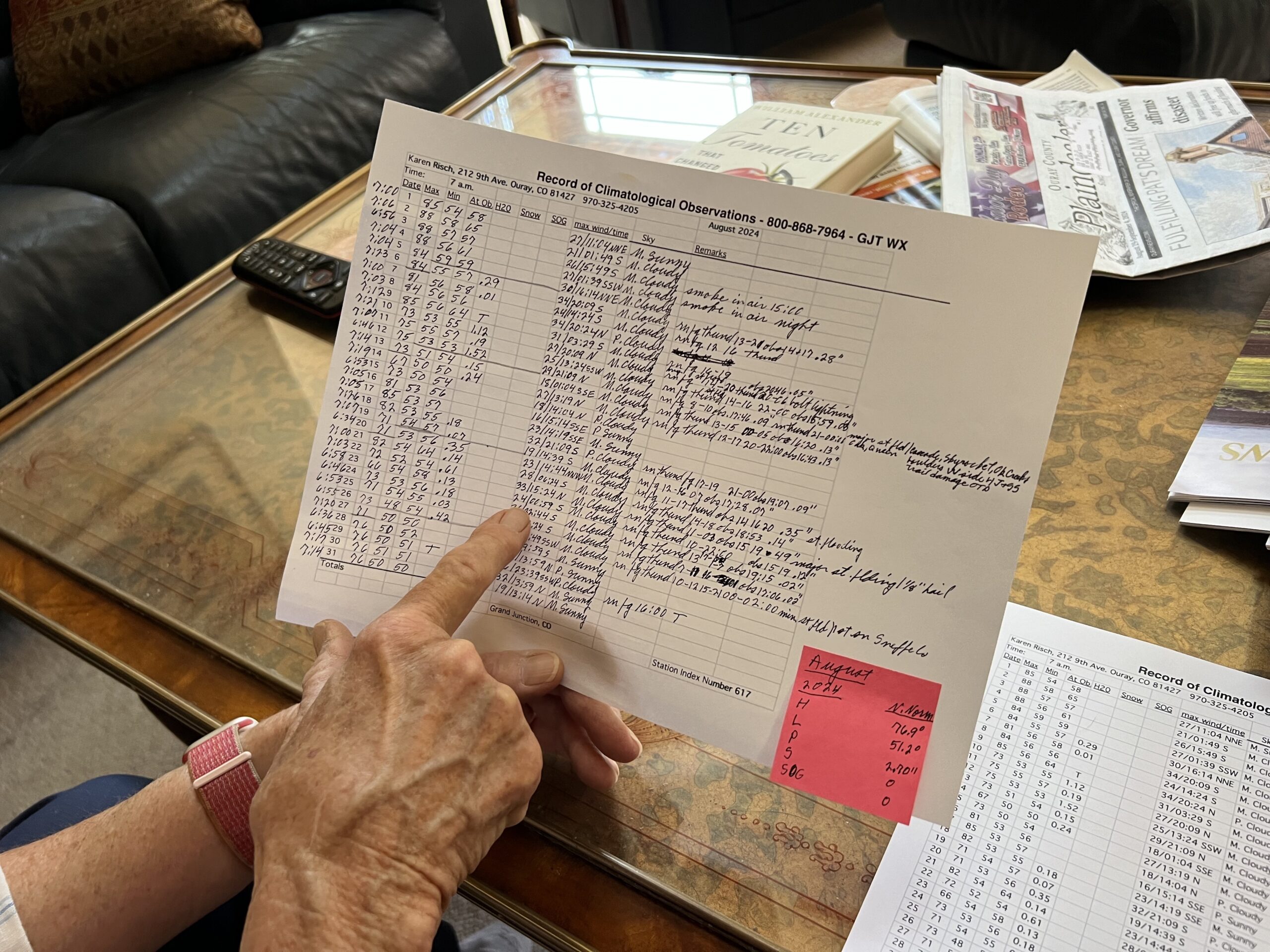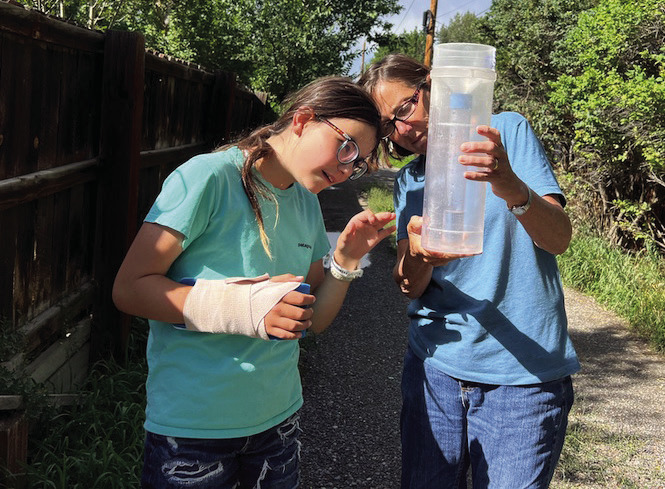Every morning, Karen Risch drinks a cup of coffee, puts on a sun, rain or snow hat and heads to her yard. She checks eight different instruments to collect weather data: gathering temperature highs and lows, precipitation amounts, wind speeds, cloud cover, air quality and other observations.
She writes them down on scraps of paper, has another cup of coffee, and then reports the information to the National Weather Service in Grand Junction and a community-run weather reporting network.
Each day those observations build on a nearly eight-decade-old archive of weather data in Ouray, providing data for climate scientists and, most recently, evidence for weather-related disaster conditions in the area.
Last week, Gov. Jared Polis declared an emergency disaster in Ouray County, unlocking assistance from the state and potential financial aid. Risch and other weather watchers here in Ouray County keep track of daily weather conditions and help build an official record.
“Without information like that, and the quality of it, the governor would have a difficult time being able to accurately pronounce a disaster declaration for an area based on weather,” said John Kyle, NWS data acquisition program manager.
Risch is one of Ouray County’s dedicated citizen scientists who gather and report weather data each morning. She has served as the city of Ouray’s NWS observer since 2006 and as a volunteer for the nonprofit weather watching group, Community Collaborative Rain, Hail and Snow Network (CoCoRaHS) based out of Fort Collins since 1998.
The 80-year-old Risch barely reaches her 5-foot-tall snow-measurement board that sits permanently in her backyard.
Since 2006 Karen Risch has carried the torch as the city of Ouray’s National Weather Service observer. Her observations build on the city’s nearly 8-decade archive of weather data, and played a role in supporting the state’s recognition of the county’s recent weather emergencies. Lia Salvatierra – Ouray County Plaindealer/Report for America
As a long-time author, teacher and mapmaker, Risch said she mostly kept her eye on the weather as a gardener, but got into the business of formally observing conditions as a weather spotter. In 1997, the year after she and her husband moved to Ouray, she began reporting for the NWS during extreme weather events. A year later she also start- ed observing for CoCoRaHS, contributing to the nonprofit’s community-based effort to fill in NWS coverage gaps. After nine years as a spotter, she was selected as the city’s designated NWS observer after her predecessor died.

Risch carries two of her four snow-measurement tools out to the yard. On the left, the white rocket-shaped structure houses a special precipitation-assessment tool used for cumulative, monthly measurements. Risch has accumulated supplementary weather-measurement tools for her own records over the years, allowing her to collect data beyond the requirements. Lia Salvatierra – Ouray County Plaindealer/Report for America
Risch’s job is to carry on the city of Ouray’s NWS rain and precipitation observations dating back to 1947; the city also has one full year of measurements from 1895 and a few other scattered records that are factored into cumulative averages, Risch said. The town of Ridgway has full records of this data since 1983.
Since accepting the position she’s never missed a day, though there was a close call last week when a bear broke through her fence to steal some peaches and took down her NWS-issued temperature system with it.
But Risch has backup: She has a second temperature gauge, an anemometer for reading the wind speed, a tool for measuring air quality and an extra snow-measurement board.

Karen Risch carefully takes her weather measurements each morning, compiling them into a hardcopy spreadsheet before sending them off to the two weather stations she reports for. Risch takes many of her own observations in addition to those required. Lia Salvatierra – Ouray County Plaindealer/Report for America
For her personal records, she also closely tracks extra measurements related to the water year starting in October and ending in September.
In her tenure she’s recorded a number of record-shattering numbers — most recently the 5.63 inches of rain that soaked Ouray in August, breaking the previous record of 5.28 in 1982.
These numbers can be compared to the “new normal” measurements, which is the average taken over a 30-year period, allowing scientists to track changes over time. This 30-year window is uniquely split in Ouray between 1990-2006 and 2006-2020 after Risch moved the weather observing to her home, and NWS restarted the records in the new location.
But this still allows for comparisons to be made. For example, the “new normal” average for August rainfall between 2006-2020 is 2.70 inches, which was nearly doubled by this year’s record rainfall, Risch said.
It’s uncommon to have such long and well-kept records as Ouray does, Risch said.
“I think I’m part of an amazing army of people worldwide who fuel scientists’ observations of climate change, because without these observations going back to the 1800s you couldn’t talk about climate change,” she said.
Risch continues to educate herself on weather phenomena across many platforms and said she plans to keep weather-observing as long as her health allows.
“I may die in harness. The two [observers] before me have,” Risch said.
***
Ten miles away in Ridgway and at the beginning of her weather-watching career is 11-year-old Julia Coburn. She takes over for her next-door neighbor, Jennifer Cram, another official NWS weather observer, when Cram is out of town. The job started out as a cat-sitting gig, but two years ago Cram decided Coburn was up for the task and has mentored her since then.
For Cram, who has a doctorate in atmospheric science, the volunteer role somewhat fell in her lap. She moved to Ridgway in 2019 into a house with a weather station, where a previous observer lived.
Without kids of her own, Cram said she’s enjoyed watching Coburn grow up next door and demonstrate a wide variety of interests, especially in the natural world. She knows the names of many bugs, butterflies and plants.
“I just want to be one more person that’s showing her that you can do anything that you want,” Cram said.
Cram said it’s especially important to encourage young girls to lean into their intelligence, something she sees a lot of in Coburn. Coburn just started sixth grade at Ridgway Secondary School and though she’s just getting used to her classes she said her favorite subject is science and her favorite season is spring.
“Mud season is spring, and also my birthday is in spring,” she said.
Her parents report back to Cram that she always hops out of bed with extra pep to take the measurements on time in the morning before school. Coburn said she prefers measuring the rain over the snow.
While measuring rainfall last Friday, she pointed to where the measurement should be taken at the bottom of the water’s surface tension curve.

Julia Coburn, 11, measures rainfall with her neighbor, Jennifer Cram, who is an official National Weather Service weather observer based in Ridgway, on Aug. 30. The measurement taken that day broke a new record for August rainfall at 4.01 inches, up from 3.81 in 1984. Lia Salvatierra — Ouray County Plaindealer/Report for America
“Do you remember what that’s called?” Cram asked.
“It’s the meniscus,” Coburn confidently responded.
The measurement they took together that day brought the month’s total rainfall to a record measure of 4.01 inches, breaking the previous record of 3.81 inches from 1984. The measurement is also the sixth-highest of any recorded month to date, Cram said.
She said the town’s recent disaster declaration and governor- declared disaster illustrates why it’s important to not miss a day. Leaving Coburn the task when she is out of town means Cram trusts her with the responsibility of maintaining Ridgway’s 40-year-old archive.
“It’s something that needs to be done… and it’s just part of being in the community,” Cram said.
***
Filling out the broader weather watching network is CoCoRaHS county coordinator Tim Spangler, who oversees nine citizen scientists in the county – including Ridgway Mayor John Clark – who help fill in NWS service gaps.
Spangler has a 50-year meteorological career under his belt and is a CoCoRaHS observer himself on Log Hill and an NWS spotter for the area.

Tim Spangler, the county coordinator for Community Collaborative Rain, Hail and Snow Network (CoCoRaHS) based out of Fort Collins since 1998, shows off how he bird-proofed his rain gauge. With a doctorate in atmospheric science, Spangler has applied his expertise to many roles, most recently as with CoCoraHS and as weather spotter for the NWS. Lia Salvatierra – Ouray County Plaindealer/Report for America
He worked to design the NWS spotter training program in the 1990s, and said it was fun to go through the training himself years later. He considers building out a greater network of weather watchers — beyond what the NWS can afford — especially critical on the Uncompahgre Plateau, where steep elevation changes make for diverse weather pockets, Spangler said. On Log Hill he operates two weather gauge systems, one for CoCoRaHS and a different system paid for by Divide Ranch.
Spangler was deciding between meteorology or forestry during his undergraduate studies when he saw a lightning storm blow up an outhouse in Idaho, where he was stationed with the U.S. Forest Service during a summer job. It was weather studies from then on; he went on to get a master’s in atmospheric science from the University of Wyoming and a doctorate in meteorology from Utah State.
He has contributed his weather expertise as an air pollution meteorologist across the West, a professor at Northern Illinois University, a consultant for several international weather organizations including for the Winter Olympics in Korea.
Spangler also has an email newsletter with about 50 subscribers that he uses to send out weather-related commentary. His favorite part is predicting the first snowfall a week before anyone else does.
“When I’m wrong, I remind them that they get what they pay for,” he said.
Spangler champions the idea of citizen scientists like himself, Risch, Cram and Coburn, because of how their work serves the community, but also as the backbone for weather records, research and even private weather services.
He likes that regular people take on all that responsibility.
“I like that term… American citizens are doing science and providing this data,” he said.
Lia Salvatierra is a journalist with Report for America, a service program that helps boost underserved areas with more reporting resources.
Editor’s note: This is the latest in an occasional feature we publish about community members who might not otherwise make the news. These include stories about hobbies, service, or just “people stories.” If you have someone you think would make a great “neighbors and helpers” story, email erin@ouraynews.com.

